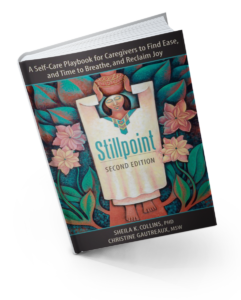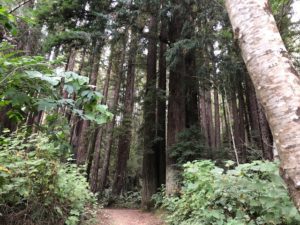 In the past ten days, I’ve been on what my husband and I call a “vacation vacation.”
In the past ten days, I’ve been on what my husband and I call a “vacation vacation.”
This is a trip we take where we are not visiting relatives, where neither of us is giving a presentation or consulting with a client. We are just resting and relaxing, a true R and R.
The point of most vacations is the notion of a change of scenery, but in our version of the “vacation vacation,” the scenery or communing with nature is the main focus. It becomes important that we re-experience ourselves as belonging to nature, as part of the more-than-human world, connected to what the first peoples call, “all our relations.”
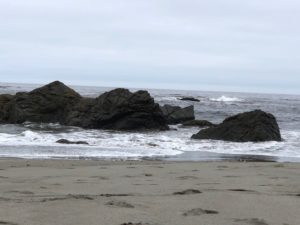
This body-oriented self-care practice started over 40 years ago when we took our first trip together to the Pacific Northwest to work with the dancer Anna Halprin in her studio in Marin County and at her place on the coast at the Sea Ranch. Beginning each day with her movement ritual, usually performed outside on a deck, we got into our bodies and began to discover what we’d done to them as we lived our future-oriented workaholic graduate student lifestyles of the time.
Fast forward to this week, getting out of our heads and back into our bodies while connecting to the environment of beach and meadow, starry night sky, redwood forest and dry river bed has been providing the opportunity to heal from the overdoing of our challenging work lives, from the “too much of a good thing” that our lives often become.
We jump-started our week at the Sea Ranch by spending a day and a half with Jamie McHugh*, a colleague we met at Anna’s, who has further elaborated on her work and the work of other body wise systems, developing his own version of what he calls “Embodied Movement Meditation.” He guided us through breathing practices and strategies to connect more deeply with our own bodies while at the same time, connecting with the natural environment of the beach and forest. http://somaticexpression.com
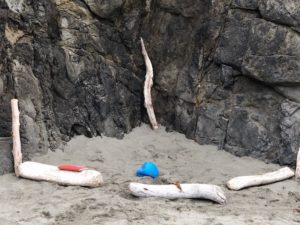 Coming to nature for a healing has a long tradition in many cultures around the globe. Going to the waters of natural springs, spending time in the open air away from the smog of city life, and taking walks, or daily constitutions, all ways to find or reestablish health. Japanese people’s term for “Forest Bathing” is “Shinrin Yoku, and it is now part of an eco-tourism industry where people travel there to be guiding in the practice.
Coming to nature for a healing has a long tradition in many cultures around the globe. Going to the waters of natural springs, spending time in the open air away from the smog of city life, and taking walks, or daily constitutions, all ways to find or reestablish health. Japanese people’s term for “Forest Bathing” is “Shinrin Yoku, and it is now part of an eco-tourism industry where people travel there to be guiding in the practice.
There is now science behind many of these practices as Stanford University and others conduct studies before and after a person participates. According to M. Amos Clifford, Founder of the Association of Nature and Forest Therapy Guides and Programs, “Being mindfully in a natural setting resets our nervous system, decreases ruminations (which enhances our mental health), and improves the overall functioning of our immune systems.”
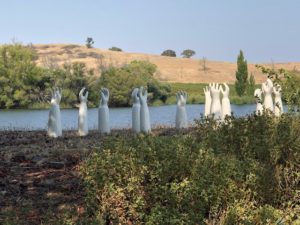 As we finish our time here on the coast, we’ll be paying attention to ways to bring back what we have been practicing here in nature as self-care for our regular lives. One principle I hope to keep in mind – it has taken time to slow down enough to become in tune with the natural world, and to do what we remind each other to do in InterPlay, to “go the speed of the body.” Walking beside a body of water or breathing in and out synergistically with trees makes that slower rhythm easier to find and maintain in the hubbub of our too busy-crazy world.
As we finish our time here on the coast, we’ll be paying attention to ways to bring back what we have been practicing here in nature as self-care for our regular lives. One principle I hope to keep in mind – it has taken time to slow down enough to become in tune with the natural world, and to do what we remind each other to do in InterPlay, to “go the speed of the body.” Walking beside a body of water or breathing in and out synergistically with trees makes that slower rhythm easier to find and maintain in the hubbub of our too busy-crazy world.
Sheila
*Jamie McHugh’s work is also talked about in my new book:
Stillpoint: A Self-Care Playbook for Caregivers to Find Ease, and Time to Breathe, and Reclaim Joy. We are having a national launch for this book on Wednesday, Sept. 12th. If you buy the book Wednesday on Amazon you are eligible to win a custom-made Self-Care Kit (valued at over $200) and also instantly have access to some amazing give-a-ways that other authors have contributed. www.stillpointselfcareplaybook.com
